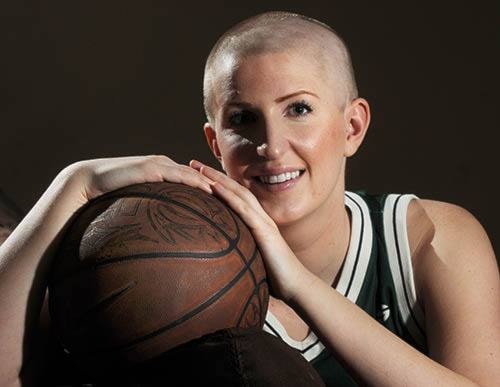Carling Muir has had a 10-year fight with brain cancer, but after a cutting edge new procedure, she hopes to finally have respite.
Muir is just the 20th person to receive an innovative, high-tech treatment for brain cancer. It is a robotic laser that uses heat to destroy cancer cells, while the surgeon watches his progress on a monitor.
Muir’s story was last told in 2011, when the six-foot-one basketball star out of Thomas Haney secondary was the heart and soul of the Langara College Falcons women’s basketball team. She won scoring titles despite undergoing chemotherapy treatment.
In 2006, she was on the court when she suffered a seizure. Just about to start a game, the Falcons did a cheer, “One, two, three Langara!” Then she collapsed. She was diagnosed with an egg-sized tumour on the left side of her brain and rushed into emergency surgery.
She asked the doctor, “Am I going to die?”
She had the first tumour removed a decade ago, but she has been re-diagnosed three times over the past years. She estimates she has spent a combined three years taking chemotherapy treatment over that 10 years.
“I’ve had my ups and downs. I’ve had really strong support from family and friends.”
The new NeuroBlate technology is rare in Canada. It first came to Vancouver General Hospital last year, thanks to a $350,000 donation in memory of Eleni Skalbania.
Eleni is the wife of famed entrepreneur and sports team owner Nelson Skalbania. Eleni died after lung cancer spread to her brain in 2013.
Dr. Brian Toyota is the only surgeon in Canada doing the procedure. Hospitals in Toronto and Montreal have recently acquired the NeuroBlate technology, and are training in its use. There are 44 such machines in the U.S.
Muir said it was much easier than having the tumour removed, as previously required.

The procedure involves drilling a hole about the size of a pencil into the skull, but for Muir that was not scary.
“It’s a lot less invasive – they don’t have to open up my whole head,” she said. “I had 40 staples in my head.”
Instead of taking off a section of skull, removing the tumour and re-attaching the skull, the surgeon is able to precisely target a tumour.
As Toyota said, doctors “aim the laser right down the barrel of it.”
With the technology he can access deep tumours, and those which might otherwise be inoperable. The patient stays connected to an MRI, which the doctor can use to target the cancer.
Toyota said it is too early to say whether the procedure will save lives or increase life expectancy for cancer patients – but that is everyone’s hope.
Muir was awake during the 40-minute procedure, and there were some unique sensations as the surgeon did his work.
“I felt like there were Pop Rocks going off in my head.”
There was also a light, burning sensation, but no serious pain.
As soon as the procedure was done, she was able to get off her bed and go to the washroom. Then she napped, and walked out of the hospital 12 hours after the surgery.
“I have so much appreciation for Dr. Toyota and his team. They’re an amazing group of people,” she said.
Now, Muir is undergoing chemotherapy, to obliterate any remaining cancer cells the surgeon missed. She feels good.
“Other than being really tired, I can’t complain.”
Carling lives in Coquitlam, and is an outreach worker in the Surrey school district.
Her parents, Grant and Shelley Muir, still live in Maple Ridge. They took part in a recent CBC documentary about the new treatment that featured their daughter. Carling got emotional as she talked about how hard her cancer battles have been on the family.
“That was hard to watch,” said Shelley. “With everything she going through, that she would worry about her family …
“It has been hard on the family,” said Shelley. “There can’t be anything harder than to watch your child fight cancer.”
Toyota said the procedure is not a cure for brain cancer.
“The cure for cancer will be different, even for people who have the same cancer,” he said. After having done the procedure with 20 patients, he is confident that it is producing good results, and it “hasn’t hurt anyone.”
It’s innovative, and that’s important to him.
“If you’ve solved a problem, then it’s okay to keep doing the same things,” he said. “If you haven’t, you better be doing something innovative.”
It wasn’t even an option for Muir when she was first diagnosed with a tumour.
“Ten years ago this was still an experiment in a lab in Winnipeg.” It’s almost a cliche, but it is relevant to tell cancer patients to keep fighting, because medical science keeps improving.
